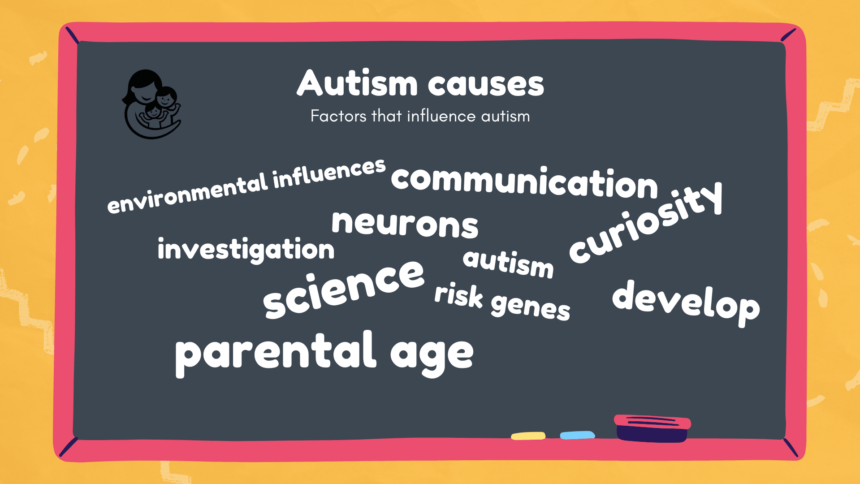Autism is one of the most complex and misunderstood conditions in the world today. Many wonder: what causes autism-is it something a child is born with, or does it develop from environmental causes? This comprehensive guide to autism causes seeks to explore these in depth and provide a clear, balanced view that will demystify the myths and misconceptions surrounding this condition. It is termed Autism Spectrum Disorder, a condition wherein a range of conditions exist with impairment in social interaction and communication along with peculiar sensitivity to sensory inputs. Understanding the cause of autism will help the parents, teachers, and society at large to support these individuals more effectively.
What Are the Main Causes of Autism?
In discussing the causes of autism, one must consider that there is not one cause. The causes of autism are varied and involve both genetic and environmental factors, which influence the development of autism in different ways. The etiology of autism has a remarkably high heritability, indicating a significant genetic component. However, environmental factors also contribute, particularly those affecting a child during pregnancy and early development.
1. Genetic Factors: The Role of Genes in Autism
autism has a remarkably high heritability, indicating a significant genetic component. However, environmental factors also contribute, particularly those affecting a child during pregnancy and early development.
1. Genetic Factors: The Role of Genes in Autism
There is a big genetic component to autism. Studies have implicated many different genes in the cause of autism; most function in the developing brain. Changes to these genes can alter how brain cells communicate with each other and lead to autistic traits. Some of the genes influence the formation or pruning of synapses-the points at which nerve cells connect to each other.
Genes That Contribute to Autism
- Gene Mutations and Variations:Specific gene mutations have been cited as being related to autism, and some may not produce autism on their own. However, these variations together with other genetic or environmental components can contribute to the threat of developing autism.
- Family History: Families with a history of autism or other developmental disorders have a higher risk of having a child on the spectrum. This points to genetic inheritance of traits that might contribute to the condition.
Genetic testing and neuroimaging have made various advances in the field of autism causes, but these findings indicate that it is not caused by a single genetic anomaly-it’s a mix of many genetic elements that can cont
2. Environmental Factors Contributing to Autism
Though genetics is considered a central role in the causes of autism, there are also environmental factors that highly influence the development of autism. The majority of these factors do affect how a child’s brain develops during pregnancy or in early years of life.
Key Environmental Influences
- Parental Age: Advanced age of parents, particularly the father, is associated with an increased risk for autism. As people get older, so is the chances of genetic mutations.
- Maternal Infection: Maternal infection during pregnancy can be one of the causes of autism. Researches indicate that severe maternal infections may affect the fetal brain and lead to autism.
- Prenatal Exposure to Medications or Toxins: Intake of certain medications, especially during the first trimester, and certain toxins, including heavy metals, increase the risk of autism. For example, it has been observed that the use of valproic acid in pregnancy can increase the risk of autism; this drug is used to deal with epilepsy.
- Premature Birth and Low Birth Weight: is also associated with an increased prevalence of autism since it relates to the interruption of proper brain development.
3. Synaptic Formation and Connectivity: How the Brain Develops
Synaptic development of the brain, or how the neurons connect, is a significant link in the causes of autism. In typical development, the synaptic connections that allow neurons to communicate are carefully regulated. In an autistic brain, this regulation may be different, leading to enhanced or reduced connectivity between brain areas.
Research has confirmed that the brains of most individuals with autism have more interconnections than usual, leading to their different ways of processing information. This increased neuronal connectivity may be the underlying reason for the observation among some persons with autism-while they may notice details they easily perceive, they seem to miss the big picture.
Mirror Neurons: A Critical Component in Understanding Autism
It is believed that mirror neurons are responsible for the mimicking of behaviors, forming the very basis of learning through imitation. For instance, babies learn to smile back when they see someone else smiling. In autism, such neurons may contribute to impaired functioning in the expression of emotions or understanding the feelings of others. This therefore suggests that abnormalities in the activity of mirror neurons might be one of the important aspects of autism causes related to social and communicative difficulties.
Sensory Processing in Autism
Generally, this population suffers from sensory overloading or input of more sensory material into their system than the human brain is able to handle properly. This difference in how information processes into the brain is core for autism causes.
A typical brain filters out the irrelevant stimuli to focus on the essential aspects in the environment. However, an autistic brain absorbs it all without filtering, which increases the level of overwhelm and may lead to stress. This is not only a determining factor in how autistic people perceive their environments but also plays a huge part in the behaviors of stimming-including fidgeting, rocking, hand-flapping-that help reduce overwhelming sensory input.
The Role of Sensory Overload
- Auditory Overload: Many individuals with autism might act like covering their ears to mitigate the impact of loud sounds. This is because, while most people can filter the sounds, they become very overwhelming to the individual with autism.
- Visual Overload: Some autistic people do not make eye contact because it is too much, and it feels uncomfortable. The bright lights and the concentrated focus that go along with it make the contact distressing.
- Tactile Sensitivities: Wearing loose clothes, avoiding certain textures, or insisting on particular fabrics are ways autistic people manage tactile sensitivities.
Common Misconceptions About Autism Causes
There are lots of misconceptions when considering the causes of autism. Unfortunately, misinformation perpetuates stigma for autistic individuals. Let’s clear up a few of the common myths:
Myth 1: Vaccines Cause Autism
Perhaps one of the most popularly spread myths about autism is that it is caused by vaccines, specifically the MMR vaccine for measles, mumps, and rubella. No scientific basis exists to support this fact. Several large-scale studies have concluded that no link can be established between vaccination and the incidence of autism. Vaccines save lives, and it is important to dispel this myth so that outbreaks of preventable diseases can be avoided.
Myth 2: Bad Parenting or Emotional Detachment
Past misbeliefs included that autism was a product of bad parenting or even an emotionally absent mother-something often called the “Refrigerator Mother Theory.” These days, it is widely known that autism is caused largely by genetics and the environment, with no proof of support for this outdated and misleading theory.
Myth 3: Autism Can Be “Cured”
Autism is not a disease; therefore, it cannot be “cured”. It’s a neurodevelopmental condition, influencing how individuals perceive and interact with the world. Helping to understand this concept can provide one with an atmosphere of acceptance rather than attempting to change or “fix” someone.
Neurological Differences in Autism: Understanding the Brain
The autistic brain differs from a typical brain in many ways, especially in connectivity and information processing. Neuroimaging studies show differences in both structure and function between autistic and non-autistic brains. These differences are often visible in regions of the brain involved in social interaction, sensory processing, and emotion regulation.
Neuroanatomical Changes
- Increased Connectivity: Some areas of the autistic brain are over-connected, while others are under-connected. It is this over- and under-connectivity that produces both the difficulties and strengths of autistic individuals.
- Size Differences: Some research has identified a difference in the size and rate of growth of the brains of young children with autism. For some, there is a period of rapid growth in brain development at an early age, which may be associated with the condition.
The Importance of Early Diagnosis and Intervention
It’s usually the case that the root cause of autism and early warning signs are crucial to bringing forth appropriate support. Symptoms usually show up during the beginning of a child’s years, and early diagnosis gives ways to children to get needed intervention to help them in overcoming challenges and building their strengths. Early Intervention services-speech therapy, occupational therapy, and behavioral supports-can make a huge difference in the developmental trajectory taken by an autistic child.
Signs to Look Out For
- Social Challenges: Inability to establish eye contact, minimal interest in interacting with peers, and an inability to understand social cues may all be early signs of autism.
- Communication Delays: Some children on the spectrum have delays in speech development, develop repetitive speech, or limited gestures.
- Repetitive Behaviors: Common behaviors such as hand-flapping, rocking, or repeatedly stacking objects may be indicative of the presence of autism.
Intellectual Strengths in Autism
While autism itself has been linked to a whole host of challenges, focusing on intellectual strengths possessed by many with autism is warranted. Autism triggers a different style of relating to the world, one that may translate into numerous intellectual capabilities seemingly at lower levels within the general population.
- Great Attention to Detail: Many people with autism possess an incredible ability to focus on minute details that may be overlooked by others. This can be a huge advantage in fields requiring meticulous attention, such as data analysis, quality control, or coding.
- Intense Interest in Specific Subjects: In several cases, people with autism develop deep interest in a particular subject that turns them into experts. It could provide great academic or professional success regarding the same subject area.
- Excellent Memory: A number of autistic individuals possess a really good memory, which especially can be seen concerning facts and figures or visual patterns. The strength may become of utmost use in different academic or professional situations.
Conclusion: Autism Causes and the Path Forward
Understanding the causes of autism is a complex but rewarding journey. It’s about understanding that autism is part of human diversity-a different but valuable way of experiencing the world. Genetics, environmental factors, synaptic connectivity, and sensory processing all make for a rich tapestry constituting the autistic experience. With early intervention, proper support, and an inclusive mindset, autistic individuals are not only able to rise above the challenges they face but also shine in their own way.
We must quit looking at autism solely as a litany of deficits but instead begin to focus on the strengths and potentials it brings. Understanding and supporting autistic individuals is important so that full opportunities to live productive, fulfilling lives can be realized. The causes of autism may be many, but one thing remains certain: autistic people are an essential part of our global community.
For a more personal perspective on living with autism, don’t miss this inspiring journey of a mother raising two autistic children and the insights she shares.
For more official insights and up-to-date information on autism, visit the CDC’s comprehensive resource on Autism Spectrum Disorder (ASD): CDC – Autism Spectrum Disorder (ASD).

